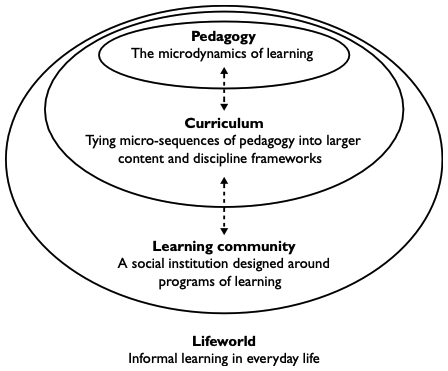Education’s designs
Education is a social relationship of learning that has been consciously designed. In our nature as humans, we learn anywhere and everywhere. Learning is an integral part of our lifeworld experience. Informal learning is a casual part of lifeworld experience. The learning that we call ‘education’ is different in this main respect: education is learning by design. The hallmarks of education are deliberate pedagogical actions, organised sequences of learning, specialised texts, dedicated teaching roles and specialised educational institutions. In this chapter, we examine these hallmarks of education through two dimensions of teaching – pedagogy and curriculum.
Pedagogy creates for learners a series of scaffolded performances of knowing. It has learners do a sequence of actions that have a narrative structure. The story of pedagogy mostly runs like this. It starts with an orientation, then a journey with some activities, and ends with a knowledge destination. Here is an example:
Orientation: Students in classroom, teacher at the front of the room: ‘Hey, kids. Today we’re going to do volcanoes [or the pyramids, or whatever]. Turn to Chapter 11.’
Journey: ‘Let’s read the chapter, talk about the chapter and find out more information from the library/ Internet. Then write a volcanoes/pyramids report.’
Destination: ‘We’re getting to the end now, so let’s do the volcanoes/pyramids test.’ Or, ‘Finish your project now and hand it in.’ The teacher then gives each student a mark for their efforts. The students know the narrative is over when the teacher gives the students back their marks, then says, ‘Okay, now turn to Chapter 12, on Ancient Rome [or rivers, or whatever].’
Here is another example, using the concepts developed in the ‘Learning by Design’ project (The Learning by Design Website, n.d.; Kalantzis and Cope 2010):
Orientation: A group of students in the class has negotiated with their teacher to investigate the life cycle of a local pond, linked to the state or national curriculum standards.
Journey: The teacher designs a sequence of ‘knowledge processes’, or activities, including (in any particular order, moving backwards and forwards between different knowledge processes):
- Experiencing the known: Survey parents and/or other students on a range of concerns about and everyday understanding of the ecosystem of the pond. What more do we need to know to develop a well-informed understanding of the pond?
- Experiencing the new: Visit the pond. Examine it carefully. Undertake some scientific tests. Record data.
- Conceptualising by naming: Research and define key scientific concepts that describe life cycles.
- Conceptualising with theory: Develop a theory of life cycles in an ecosystem.
- Analysing functionally: Model the life cycle diagrammatically.
- Analysing critically: Model disruptions to the life cycle, such as pollution or the effects of development. Who is responsible for these? Investigate problem sources and plan possible solutions.
- Applying appropriately: Write a scientific report of your findings.
- Applying creatively: Develop a management plan for the pond and present it to the local council. Apply life-cycle concepts and theory to a new setting, such as a forest.
Destination: Self-assessment and peer assessment of activities as represented in a research report; external assessment by an expert such as an environmental scientist, a representative from local government or parents. Learning outcomes are aligned to those expected in the curriculum standards.
Curriculum is a larger framework for learning. In the earlier example, pedagogy was occurring within the hypothetical Chapter 11. Localised sequences of activity had students read the chapter then answer the questions at the end. Curriculum in this example is all the chapters in the textbook, which covers the whole course for the school year, culminating in the end-of-year test. Or, to take the example of the sequence of activities undertaken by students as they study the ecosystem of a local pond, the curriculum might be Year 8 Biology. Pedagogy is the mix and sequence of activities about the pond, aiming to explore the concept of the life cycle in an ecosystem.
Curriculum ties the micro-sequences of pedagogy together into the larger frameworks or macro-sequences of learning design that we call courses or subjects. The plan for a program of learning in a curriculum is sometimes also called a ‘syllabus’.
In Chapter 2, we described three different kinds of experiences of education: didactic, authentic and transformative. In this chapter we discuss the design principles and processes that underlie each of these kinds of experience. These are, respectively, mimetic, synthetic and reflexive. We investigate each of these according to the following dimensions:
- dimension 1: pedagogy
- dimension 2: curriculum.

